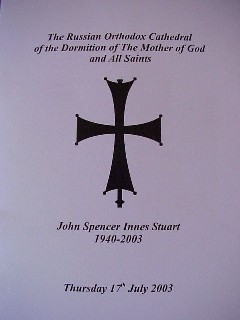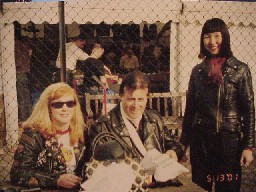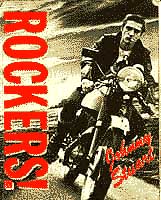 Commentary : It is always interesting to look
under the hood, behind the facade, to seek the truth and not just eat
what the media or establishment tell you. Who were the Rockers and the
people that made them? Finding out the truth might shatter a few
pre-conceptions and take the wind out of media prejudices but will
ultimately set true individuality free.
| Johnny Stuart 1940-2003, Rest In Peace. Author of the allegedly most shop-lifted book in London bookshops, a book called ...
" Rockers! Kings of the Road "
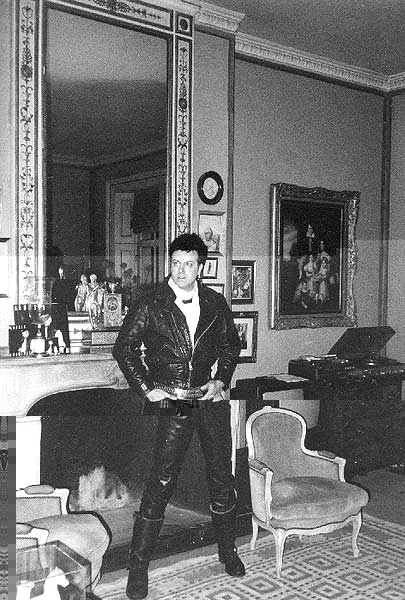
From the Daily Telegraph, 21st July 2003 Johnny Stuart, who has died aged 63, had no equal outside Russia as an expert on Russian art. The thriving market in Russian art today is largely his creation. He founded the Russian department at Sotheby's in 1976 and over the next 20 years built it up into a dominant position that was reflected in Sotheby's record-breaking Russian sale of 1995. No aspect of his field left him indifferent. Aside from his principal interest in icons, he was equally fascinated with Russian painting of the 18th, 19th and 20th centuries, as well as with porcelain and objets d'art. His book Ikons, published by Faber & Faber in 1975, remains the most accessible general work on the subject. Stuart later undertook a far more ambitious and in-depth project, and shortly before his recent illness, after 20 years of study, he had completed the manuscript for Icons: The Triumph of Orthodoxy, a huge, comprehensive volume which is soon to be published by Alexandria Press. Yet to describe Stuart as an art historian in the modern, professional sense did not begin to describe him. He belonged firmly in the great 18th-century British tradition of gentlemen eccentrics, polymaths and connoisseurs. He blended high scholarship with a plethora of interests in history, genealogy, interior design, pop culture and the Rocker scene of the 1960s. For work at Sotheby's he habitually wore motorcycle leathers, and he cut a dash turning up for valuations on one of his classic bikes. His book Rockers (1987), about the English bike scene of the 1960s and 1970s, became an international bestseller and for a time was reputedly the most shop-lifted book in London bookshops; it continues to do brisk trade in Japan. John Spencer Innes Stuart was born in Aberdeen on May 20 1940 and grew up in Angus, where his father farmed after the Second World War. Johnny loved drawing, and at Eton, encouraged and influenced by Wilfrid Blunt, his art master, he sought to learn about the Italian Renaissance, Persian painting, and Chinese art. While still at school he would go up to London to rummage in the salerooms, where among other things he acquired a pair of Chinese ceremonial brass fans, described in the catalogue as having been looted by a British officer during the sack of the summer palace in Peking. Around this time, Stuart also began to show a keen interest in Roman Catholicism. His parents, alarmed at this development, asked his housemaster, G A D Tait, to do what he could to distract him, and so it was that he was given a book about the Russian Imperial Family. From there developed the great passion of Johnny Stuart's life. He immersed himself in Russia's history, culture and art, and became firm friends with the Russian émigrés Count and Countess Kleinmichel, who stood as his godparents when, while still at Eton, he converted to Orthodoxy. Stuart went on to develop these interests at St John's, Cambridge, where he read Slavonic Studies under Professor Andreyev, a follower of the leading early Byzantinist, N P Kondakov. In his holidays he moved in Russian émigré circles, and avidly sought to learn about the closing days of the Russian empire. After Cambridge, Stuart based himself in Notting Hill. His homes, first in Kensington Park Gardens and then in Colville Mews - a former industrial warehouse converted into a Russian neo-classical palazetto - became meeting places for people of vastly different backgrounds and interests. In 1963 he was engaged by Peter Wilson as a porter in the porcelain department of Sotheby's, quickly moving to be an assistant in the Russian section of the Works of Art department. The great collector of Russian Art, George Kostaki, remarked to Wilson that his porter seemed to know far more than the expert in charge. Stuart's restless and curious nature soon led him to leave Sotheby's to go into partnership with Marina Bowater at the Bowater Gallery, then a meeting place of the Russian diaspora in London. But he found running a gallery too limiting, and in the late 1960s he went to Russia to study under Adolf Ovchinnikov at the Grabar Centre for Icon Research and Restoration in Moscow. Helped by his great friend Camilla Gray, who was married to Sergei Prokofiev's son, the painter Oleg, Stuart made lifelong friends among the Russian artistic and scholarly intelligentsia. It was to be the first of many visits, and it is fair to say that Russia became his second home. The process was repeated a few years later, in the early 1970s, this time in Greece. Through another great friend and distant relative, Elmina Rangabe, he spent a year there immersing himself in its Byzantine heritage and the roots of Christian art. When he returned to Sotheby's in 1976, he managed to persuade his superiors of the need for a separate Russian department, which he then headed for the next two decades, while also doing the research for his second book on icons. His understanding of icons included a formal appreciation of them as art and a knowledge of the theology behind them. More important, it stemmed from his Orthodox faith and his complete communion with the world that gave them birth. He always insisted that the aesthetics of religious art could only be appreciated by understanding the spiritual tradition that produced it. Ever ready to discuss Patristic theology and the finer points of the Christological disputes of the 4th century, he was, though, equally keen to share his enthusiasm for classic British motorcycles. His passion for large and powerful motorcycles dated back to his schooldays. Not a day went by when he did not ride his bike and over the years he was the proud owner of several classic machines, ranging from a 1935 Thunderbird, via Nortons and Tritons to the latest model Triumph. Meanwhile, his understanding of youth culture, his enjoyment of the glamour of the music scene, and his knowledge of street style and fashion made him a guru for actors and pop stars. Among those he influenced and befriended were members of the Rolling Stones, Oliver Tobias, Zandra Rhodes, George Michael, Spandau Ballet, Gary Numan, Steve Strange, Duran-Duran, Billy Idol, Brian Setzer of the Stray Cats, Paul Simonon of the Clash, Huggi, and Kylie Minogue. The makers of films and pop videos came to him for advice on matters of style, and when the V & A held an exhibition on British Street Style, they called on him for help in styling the show and to lend motorcycles, original bikers' clothing, accessories and memorabilia from the 1950s and 1960s. Stuart left Sotheby's shortly after the Russian sale of December 1995 and formed an art consultancy with his former colleague Ivan Samarine, advising collectors and dealers throughout the world. Entrusted with their treasures, Stuart's home became an ever-changing showcase of Russian art. In recent years he fulfilled a long-held ambition - the culmination of years of absorbing the minutiae of Russian style - by renovating a large derelict apartment in the heart of St Petersburg on the Fontanka river, in the house where Turgenev once lived, and turning it into a splendid early 19th-century Russian palatial residence. Featured in Russian Vogue, along with photographs of his home in London, it led to other commissions in Moscow. Johnny Stuart was handsome, charming, self-deprecating, and an excellent host. His hospitality combined with his wide-ranging interests gave his soirees the character of a salon. A great raconteur, he was forever regaling his friends with wonderfully funny stories, and could spend hours discussing the finer points of style, interior design and architecture. Byzantium, Russian neo-classicism, the Ottoman world and Fifties Britain were his favourite styles - a synthesis reflected in his own homes. Fascinated by languages and their sounds, he spoke fluent Italian, French and Russian. Even in languages such as Greek and Spanish, his knowledge of which was far more limited, his talent for mimicry often confused natives into thinking him one of their own. Gifted with a great ear, he could render exactly the accent or vocal mannerisms of his interlocutors, always to their great merriment. He had the rare ability to communicate across generations and social classes. A bachelor, he was a highly popular uncle and godfather. He died on July 12. John Stuart Scholar of icon painting and expert on Russian history 22 July 2003
John Spencer Innes Stuart, Russian scholar and writer: born Aberdeen 20 May 1940; died Ockley, Surrey 12 July 2003.
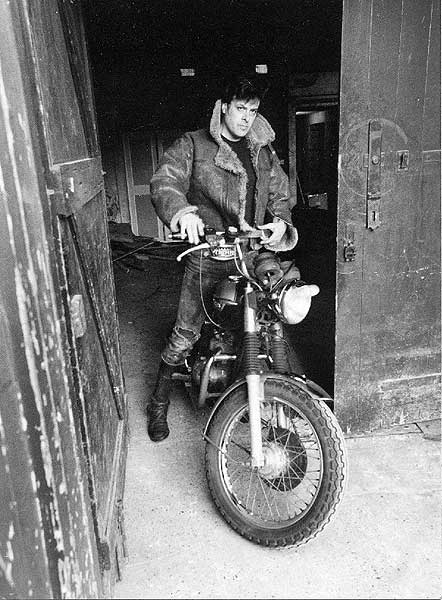
John Stuart was a leading scholar of icon painting with an international reputation, and an expert on all aspects of Russian history and culture. He was a man with an intensely developed visual sense, which he brought to bear not only in his chosen field of scholarship, but in every part of his life, from his greatly admired London house to his passion for British bikes, leather jackets and the glamour of rock'n'roll. He was born in Scotland and educated at Eton. Passionate about art and drawn to spirituality from boyhood, he converted to Russian Orthodoxy at the age of 18, and introduced himself to the small émigré community in London, one of whom, Count Kleinmichel, became his godfather. He went on to St John's, Cambridge, where he read Slavonic Studies under Dr Nicolai Andreyev, the former head of the Kondakov Institute in Prague, a pre-war bastion of Russian émigré thought and culture. His first trip to Russia was in the mid-1960s with his friend Camilla Gray, who was researching her ground-breaking book on the Russian avant-garde. In 1970 he spent a year working in the Grabar Central State Restoration Workshop for Medieval Painting in Moscow studying under the great Adolf Ovchinnikov, its leading restorer. In 1963 Stuart joined Sotheby's as a porter, and owed his quick promotion to expert status to the legendary Russian collector George Costakis who, in a meeting with Peter Wilson, the then Sotheby's chairman, informed him that the porter in the icon department seemed to know a great deal more about icons than their expert of the time. But timetables and deadlines were not his greatest strength, and Stuart quickly came to grief when a catalogue of important Russian silver only came out a day before the sale, instead of the usual month. From then on, he took the role of consultant, and from the late 1980s until 1995, the exciting period when Russian clients appeared on the international market for the first time, he oversaw every aspect of the Sotheby's Russian sales. In 1995, after overseeing undoubtedly the finest sale of Russian paintings and works of art ever held anywhere, he left Sotheby's to set up a private art consultancy business and to concentrate on his life's work, a mammoth overview of East Christian painting that will be published in the near future. His first book, Ikons, published in 1975, remains to this day the best overview of icon painting in English. He also wrote Rockers! (1987), the definitive text on post-war British bike culture, St Petersburg, Portrait of an Imperial City (1990), contributed to numerous publications on Russian art and culture, co-curated the icon exhibition "Gates of Mystery" at the Victoria & Albert Museum in London in 1990, and advised the same museum, as well as lending exhibits, for their "British Street Style" exhibition a few years later. It was in 1988 that he asked me to join him at Sotheby's. It was my first "proper" job, and it did not take long to understand what a privilege it was to be working with him. In a few weeks he redirected my entire understanding of history, art and above all quality, and made me rediscover an enthusiasm for applied learning that I had completely lost at university. Like all good teachers, he inspired loyalty and a sense of mission in his pupil. In the world of the Russian market he towered above everybody else in his knowledge and passion for his subject, and he shared this willingly with everybody. But he was also a glamorous figure, a rebel-scholar, whose arrival in Conduit Street was heralded by the roar and backfire of his Triumph bike, whose telephone book contained the line: "Johnny Rotten: (Mum's number)", and who just because he was Johnny Stuart could get away with wearing motorcycle leathers when everybody else was in a suit and tie. He would dictate a footnote on Hesychasm and 14th-century Byzantine theology, and then answer the telephone and advise George Michael or the Stray Cats on what they should wear for their next video. During these years he made many important discoveries; a parcel of dog-eared papers that appeared on his desk in 1990 turned out to be the long lost "Sokolov Archive", evidence collected at the scene of the crime of the murder of the Imperial Family lost since the 1920s. Stuart's sale catalogue made headlines in Russia, which was going through perestroika, and the archive is now in the Russian State Archive. A small panel believed by the owner to be a Russian 19th-century icon was identified by him as the only known Byzantine depiction of the Triumph of Orthodoxy (the defeat of iconoclasm) and was then acquired by the British Museum. With his uncanny ability to identify everybody, he single-handedly created a market for Imperial photographs; a sale of the personal albums of Grand Duchess Xenia, sister of the last Emperor, was widely written about in the press at the time and sold for many times its pre-sale estimate thanks to his expert cataloguing. History was alive for John Stuart; he read memoirs avidly, collected portraits and had a personal relationship with his favourite historical figures. He often started anecdotes with the words "of course, I remember when the beautiful Grand Duchess Elena Pavlovna . . ." and it soon became clear that he was "remembering" things that had happened a century ago. Once, when interrupted in one of these reminiscences by someone who questioned whether he could really have witnessed these events, he irritatedly started remembering things that happened in the 18th century. He hated historical cliché and inaccuracy; the common perception of Rasputin, for instance, was one of his bêtes noires; a sure way to make him cross was to hum Boney M's song, and the lines ". . . lover of the Russian queen". He was not her lover, nor was she a queen. In museums in Soviet times, when Imperial portraits were mysteriously labelled if they were labelled at all, he used to cause consternation amongst the curators and guards by identifying all the sitters loudly by name; worse, he used to point out buildings, and even rooms within buildings, and talk about their former inhabitants as if they were still there. But it was for this reason that he made so many friends in Russia, intellectuals and artists who were bowled over by this handsome, long-haired English gentleman who knew so much about their country, and who was not even slightly taken in by the drab fellow-traveller-ism that submerged so many foreign Russophiles. Mstislav Rostropovich, in an eloquent tribute to John Stuart, remarked that his knowledge of Russian culture was such that he often wondered whether it was not a Russian heart that was beating in his chest. He spoke many languages, and was an expert mimic, which allowed him to give the impression that he spoke a language when in fact he did not, often with unexpected results. Like a piece of linguistic blotting paper, he would absorb his interlocutor's intonations, accent, and even grammatical mistakes. When you met John, it was always obvious from his voice whom he had just been talking to. He had an extremely wide circle of friends, and his glamorous parties would see Romanov Grand Duchesses rub shoulders with members of the Clash. He loved Coronation Street, daytime TV adverts (especially ones where unfortunates received money unexpectedly just by ringing a telephone number) and the idiotic tunes of children's TV. In many ways he was an innocent in the modern technological world: he never knew what day or even month it was, and I quickly understood that his timekeeping was a sort of code: "half hour" (for some reason in a German accent) meant sometime in the future, possibly today; a "quick lie-down" would mean that you would probably not see him again until the morning. Just as time outside of John Stuart was a meaningless measure, so inside him he preserved a child-like quality, a spiritual simplicity and directness that was all-conquering. On a crowded aeroplane he once gave up his seat to a lady, and made as if to stand, bus-style, at the back of the plane: he was quickly ushered into first class. In general, he had to be shepherded around airports; on his own he more than once ended up in queues that would have taken him to Cairo when his destination was St Petersburg, and once he was found in the right seat but on the wrong aeroplane. And during his final illness, he told with relish of a visit from the hospital psychiatrist who asked him what the highest mountain in the world was, and to subtract seven from 100. He thought he got one of the questions right. He was the finest and most brilliant man. Ivan Samarine
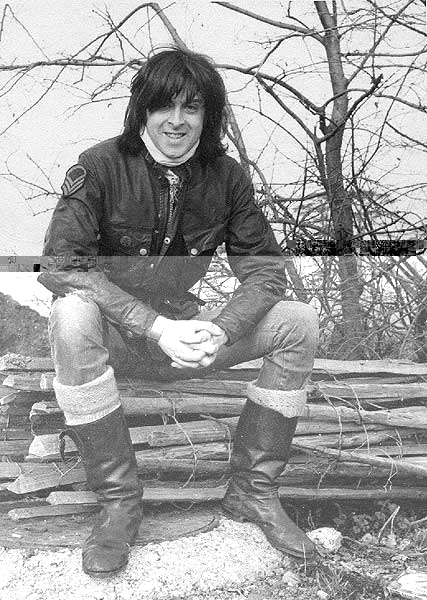 From The Times, August 06, 2003
John Stuart Expert on Russian art and icons who established a series of record-breaking sales at Sotheby's AS HEAD of Sotheby's Russian department during its formative period, John Stuart was respected for his very detailed knowledge and understanding of Russian art and culture. But he was also a very convincing mimic and an engaging raconteur ó and his love of motorbikes was almost as strong as his passion for icons. Russia snared Stuart at an early age. John Innes Stuart was the only son of an Angus landowner. He was first introduced to the art and culture of Russia while at Eton. His Scottish Protestant parents were deeply upset when he expressed an interest in joining the Roman Catholic Church, and they asked his schoolmasters to get him interested in something else. Stuart, then 15, was given a book on the Russian Royal Family and became voraciously keen to find out more about Russia's history, art and religion. He may have been encouraged in this by his art master, Wilfred Blunt, brother of the art historian Anthony Blunt. Stuart asked to be introduced to Russians in London who had escaped the Revolution, and he became close friends with the family of Count Vladimir Kleinmichel, who would later act as his godfather when he converted to the Russian Orthodox Church. Stuart went up to St John's College, Cambridge, to read history, but soon decided to change to Slavonic Studies. During his vacations he travelled across much of Russia and later spent time studying at the Central State Restoration Workshop in Moscow. On coming down in 1963, he took a job with Sotheby's as what he used to describe as a glorified porter. While he gained a reputation for his knowledge of Russian art, he also involved himself deeply in the Russian community of London, determined to perfect his Russian. Friends later complimented him on acquiring an extraordinarily good accent, even though his vocabulary, learnt from people who had escaped Russia during the Revolution, was rather old-fashioned and courtly. Stuart left Sotheby's briefly in the early 1970s to run a London gallery specialising in Russian art with Marina Bowater, an antiques collector. He studied in Moscow under Adolf Ovchinnikov at the Grabar Centre for Icon Research and Restoration, and also spent a year in Greece, immersing himself in its Byzantine heritage and the roots of Christian art. But he soon returned to the auction house in a more senior role, and in 1975 he published Ikons, his first major book. As head of the Russian department he developed a strong market in all sorts of art, from icons and paintings to silverware and furniture. At its peak, Sotheby's was conducting a big Russian sale almost every month. From 1980 until he left the company in 1996, Stuart worked as a consultant. His swansong, in December 1995, was to oversee the most comprehensive sale of Russian art in Britain to that time. The collection, ranging from Byzantium to the post-Revolution period, raised a record £5 million in what was still a fledgling market. After leaving Sotheby's, Stuart set up an art consultancy business with Ivan Samarine on the ground floor of a magnificent converted warehouse in Notting Hill. Stuart also spent a lot of time researching and writing what he hoped would be his defining work, Icons: The Triumph of Orthodoxy. Described as the first meaningful English-language study of Russian panel painting, covering the culture, history and art of Russia from the iconoclasm of the 8th century to the end of the 16th century, the book was submitted to his publishers, Alexandria Press, just before he died and will appear shortly. But it was not only Russian icons that exercised Stuart's passions. He was also fascinated by the leather-clad biker icons of the 1960s and 1970s, and would surprise visitors to Sotheby's by offering to take them for a spin around London on the back of one of his many British motorbikes, often giving a commentary in a cod-cockney accent. In 1985 he wrote a cultural history of the rocker movement, entitled Rockers! Kings of the Road, which was said to be the book most shoplifted from London bookshops, and lent George Michael one of his leather jackets for an early Wham! pop video. Stuart continued to enjoy riding motorbikes for most of his life, even though, to the teasing of his friends, he required an electric starter on his Triumph after a hip operation. When the V&A held an exhibition on British Street Style in the early 1990s they called on Stuart both for style advice and to lend motorcycles, original Fifties and Sixties bikers clothing, accessories and memorabilia. At well over 6ft, Stuart was a larger-than-life character around the streets of his beloved St Petersburg, where in later years he devoted much of his time to refurnishing a 19th-century mansion, which was formerly occupied by the novelist and philosopher Ivan Turgenev. Its lavish decoration featured in a ten-page spread on Stuart in Russian Vogue this year. Stuart was also involved in raising money for the World Monuments Fund in order to restore the Chinese palace built for Catherine the Great at Oranienbaum, just outside St Petersburg, and the early-19th-century Flag Pavilion on Yelagin Island. He was unmarried.
John Stuart, former head of the Russian department at Sotheby's, was born on May 20, 1940. He died of cancer on July 12, 2003, aged 63. |
Want to go back to the Rocker's Index for more? Click here!
